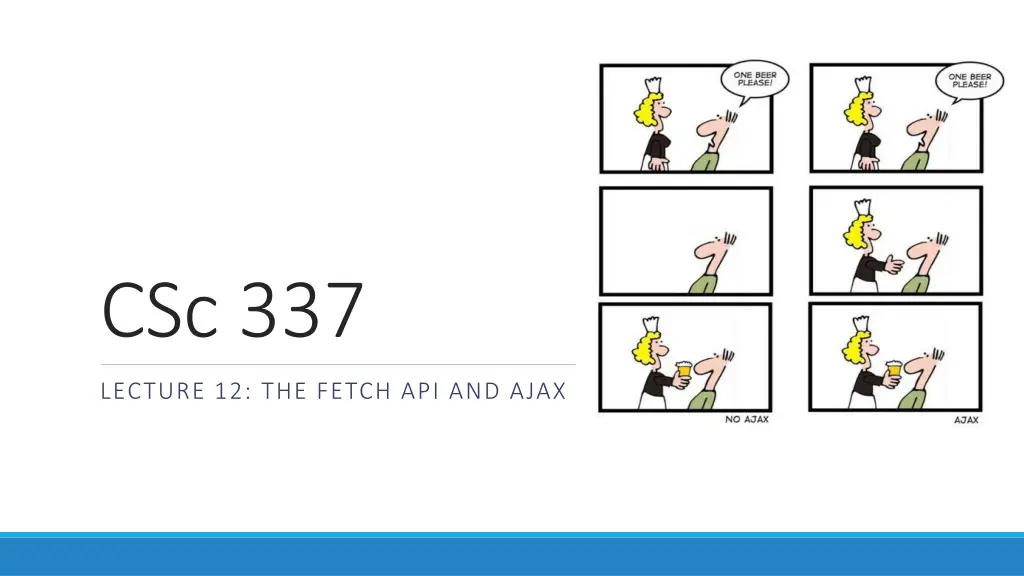
Web Communication Using Fetch API and AJAX
Learn about synchronous and asynchronous web communication, how to handle asynchronous requests, deal with request failures, and utilize promises in JavaScript for uncertain outcomes. Enhance your knowledge of web development techniques and improve user interactions on web pages.
Download Presentation

Please find below an Image/Link to download the presentation.
The content on the website is provided AS IS for your information and personal use only. It may not be sold, licensed, or shared on other websites without obtaining consent from the author. If you encounter any issues during the download, it is possible that the publisher has removed the file from their server.
You are allowed to download the files provided on this website for personal or commercial use, subject to the condition that they are used lawfully. All files are the property of their respective owners.
The content on the website is provided AS IS for your information and personal use only. It may not be sold, licensed, or shared on other websites without obtaining consent from the author.
E N D
Presentation Transcript
CSc 337 LECTURE 12: THE FETCH API AND AJAX
Synchronous web communication synchronous: user must wait while new pages load the typical communication pattern used in web pages (click, wait, refresh)
Asynchronous web communication asynchronous: user can keep interacting with page while data loads
Asynchronous requests, basic idea var ajax = new XMLHttpRequest(); ajax.onload = functionName; ajax.open("GET", url, true); ajax.send(); ... function functionName() { do something with this.responseText; } JS attach an event handler to the load event handler will be called when request state changes, e.g. finishes function contains code to run when request is complete inside your handler function, this will refer to the ajax object you can access its responseText and other properties
What if the request fails? var ajax = new XMLHttpRequest(); ajax.onload = functionName; ajax.open("GET", "url", true); ajax.send(); ... function functionName() { if (this.status == 200) { // 200 means request succeeded do something with this.responseText; } else { code to handle the error; } } JS web servers return status codes for requests (200 means Success) you may wish to display a message or take action on a failed request
Promises Promise: A JS object that executes some code that has an uncertain outcome Promises have three states: - Pending - Fulfilled - Rejected Example: I promise to post homework 4 Pending: Not yet posted Fulfilled: Homework 4 posted Rejected: Wrong homework posted, or not posted in time
Why are they better Help deal with uncertainty You determine whether it is fulfilled or rejected You define what happens when it fulfills or is rejected
Promise syntax function callAjax(){ var url = ..... // put url string here fetch(url) .then(checkStatus) .then(function(responseText) { //success: do something with the responseText }) .catch(function(error) { //error: do something with error }); }
Promise syntax function checkStatus(response) { if (response.status >= 200 && response.status < 300) { return response.text(); } else { return Promise.reject(new Error(response.status+": } } "+response.statusText));
Debugging Ajax code Firebug Net tab (or Chrome's Network tab) shows each request, parameters, response, errors expand a request with + and look at Response tab to see Ajax result check Console tab for any errors that are thrown by requests
Security restrictions Ajax must be run on a web page stored on a web server (cannot be run from a web page stored on your hard drive) Ajax can only fetch files from the same server that the page is on http://www.foo.com/a/b/c.html can only fetch from http://www.foo.com
Node.js We will be using node.js to run our server code (The code that generates what your fetch requests get) Download node.js: https://nodejs.org/en/ Double click on the downloaded file and follow the instructions to install it.
Running node.js You will need a command line to run node.js Window: you can use the built in command prompt, PowerShell (recommended), or download a command line like Cygwin Mac: there is a nice built in command line. Just search for "console" Linux: there is a nice built in command line
Testing that node is installed Open up your command line and type the following: node -v The version number of node on your machine should be output. If nothing is output or if there is an error node didn't install correctly.
Installing Express Run the following to install Express: npm install express
Node server Copy the following code into a file and name it server1.js // CSC 337 hello world server const express = require("express"); const app = express(); app.use(express.static('public')); app.get('/', function (req, res) { res.header("Access-Control-Allow-Origin", "*"); res.send('Hello World!'); }) app.listen(3000);
Running the node.js server You will need to navigate to the directory containing the file you created from the code on the last slide. To move between directories you can use: cd <directory> cd will move you into the directory specified. If you want to move into the parent directory, use .. as the directory name. If you want to see what directories exists in the directory you are in use ls to list them
Running the node.js server Once you have gotten to the directory that contains your server code, you can run it with the following command: node service1.js You will not see anything appear on the command line. To see it running open your browser and type the following in the address bar: http://localhost:3000/
Writing code to fetch from the server Write HTML and JavaScript to, when a button on the page is clicked, fetch data from the web server and inject that data into the page.






















